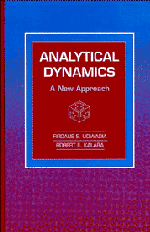Book contents
5 - ELEMENTS OF LAGRANGIAN MECHANICS
Published online by Cambridge University Press: 22 March 2010
Summary
In this chapter we will introduce the reader to the fundamentals of Lagrangian mechanics. The reader has by now had a fair exposure to the fundamental equation, and has seen how to describe constrained motion in the framework of Cartesian coordinates. Here we will delve deeper into the basics of mechanics and introduce some of the key concepts: the principle of virtual work, and the concept of generalized coordinates. We will be taking on a more rigorous approach and amplifying on several of the issues which we had to gloss over in earlier chapters so that the reader could grasp the big picture better. The first part of this chapter is in a sense going back to better appreciate the issues involved. The second part of the chapter deals with Lagrange's equations.
The chapter introduces, in a rigorous way, what we mean by an “unconstrained” system described in terms of the Lagrangian coordinates chosen to describe the system's configuration. We show that, for a given physical situation, the analyst may exercise considerable choice in what (s)he considers to be an unconstrained system. For any specific choice of an unconstrained system, we then show how to obtain the explicit equations of motion of the constrained mechanical system in terms of the chosen Lagrangian coordinates.
Virtual Displacements
The concept of virtual displacements plays a central role in mechanics. We have already seen that equality constraints of interest to analytical dynamics are of the holonomic type or the nonholonomic type.
- Type
- Chapter
- Information
- Analytical DynamicsA New Approach, pp. 131 - 174Publisher: Cambridge University PressPrint publication year: 1996

